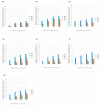Isolation, Partial Characterization and Application of Bacteriophages in Eradicating Biofilm Formation by Bacillus cereus on Stainless Steel Surfaces in Food Processing Facilities
- PMID: 36014993
- PMCID: PMC9414048
- DOI: 10.3390/pathogens11080872
Isolation, Partial Characterization and Application of Bacteriophages in Eradicating Biofilm Formation by Bacillus cereus on Stainless Steel Surfaces in Food Processing Facilities
Abstract
The Bacillus cereus (B. cereus) group is a widespread foodborne pathogen with a persistent ability to form biofilm, and with inherent resistance to traditional treatment in the food industry. Bacteriophages are a promising biocontrol agent that could be applied to prevent or eliminate biofilms formation. We have described, in this study, the isolation from sewage samples and preliminary characterization of bacteriophages that are active against the B. cereus group. The effectiveness of phage treatment for reducing B. cereus attachment and biofilms on stainless steel surfaces has been also assessed using three incubation periods at different titrations of each phage. Out of 62 phages isolated, seven showed broad-spectrum lytic action against 174 B. cereus isolates. All selected phages appeared to be of the Siphoviridae family. SDS-PAGE proved that two phages have a similar profile, while the remainder are distinct. All isolated phages have the same restriction pattern, with an estimated genome size of around 37 kb. The isolated bacteriophages have been shown to be effective in preventing biofilm formation. Reductions of up to 1.5 log10 UFC/cm2 have been achieved, compared to the untreated biofilms. Curative treatment reduced the bacterial density by 0.5 log10 UFC/cm2. These results support the prospect of using these phages as a potential alternative strategy for controlling biofilms in food systems.
Keywords: B. cereus group; bacteriophage; biofilm; characterization; eradication; inhibition; sewage; stainless steel.
Conflict of interest statement
The authors declare no conflict of interest.
Figures






Similar articles
-
Controlling of foodborne pathogen biofilms on stainless steel by bacteriophages: A systematic review and meta-analysis.Biofilm. 2023 Dec 17;7:100170. doi: 10.1016/j.bioflm.2023.100170. eCollection 2024 Jun. Biofilm. 2023. PMID: 38234712 Free PMC article.
-
Efficacy of Novel Bacteriophages against Escherichia coli Biofilms on Stainless Steel.Antibiotics (Basel). 2021 Sep 24;10(10):1150. doi: 10.3390/antibiotics10101150. Antibiotics (Basel). 2021. PMID: 34680731 Free PMC article.
-
Bacteriophage DW-EC with the capability to destruct and inhibit biofilm formed by several pathogenic bacteria.Sci Rep. 2022 Nov 3;12(1):18539. doi: 10.1038/s41598-022-22042-1. Sci Rep. 2022. PMID: 36329103 Free PMC article.
-
Characterization and comparative genomic analysis of bacteriophages infecting members of the Bacillus cereus group.Arch Virol. 2014 May;159(5):871-84. doi: 10.1007/s00705-013-1920-3. Epub 2013 Nov 22. Arch Virol. 2014. PMID: 24264384 Review.
-
Biofilm control with natural and genetically-modified phages.World J Microbiol Biotechnol. 2016 Apr;32(4):67. doi: 10.1007/s11274-016-2009-4. Epub 2016 Mar 1. World J Microbiol Biotechnol. 2016. PMID: 26931607 Review.
Cited by
-
Comparative Genomics of Six Lytic Bacillus subtilis Phages from the Southwest United States.Phage (New Rochelle). 2022 Sep 1;3(3):171-178. doi: 10.1089/phage.2022.0030. Epub 2022 Sep 19. Phage (New Rochelle). 2022. PMID: 36793550 Free PMC article.
-
The Use of Natural Methods to Control Foodborne Biofilms.Pathogens. 2022 Dec 27;12(1):45. doi: 10.3390/pathogens12010045. Pathogens. 2022. PMID: 36678393 Free PMC article. Review.
-
A Genomic Analysis of the Bacillus Bacteriophage Kirovirus kirovense Kirov and Its Ability to Preserve Milk.Int J Mol Sci. 2023 Aug 9;24(16):12584. doi: 10.3390/ijms241612584. Int J Mol Sci. 2023. PMID: 37628765 Free PMC article.
References
-
- Marchand S., De Block J., De Jonghe V., Coorevits A., Heyndrickx M., Herman L. Biofilm formation in milk production and processing environments; influence on milk quality and safety. Compr. Rev. Food Sci. Food Saf. 2012;11:133–147. doi: 10.1111/j.1541-4337.2011.00183.x. - DOI
LinkOut - more resources
Full Text Sources

